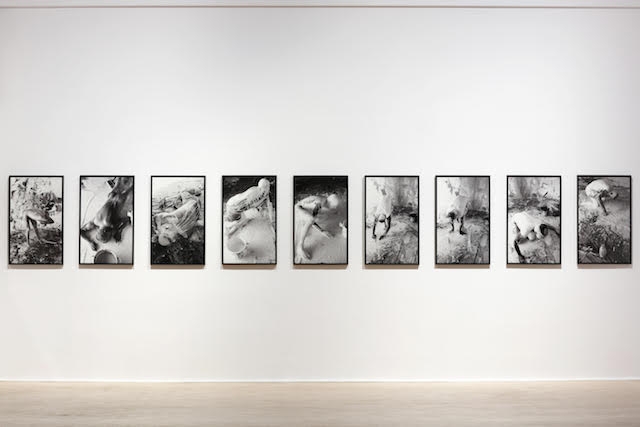It’s the opening night of Decisions, an exhibition focused on Stuart Brisley’s art of the 1970s and 80s, when he formed close ties with Poland. The crowd is encouraged to pass from the gallery through to an auditorium illuminated by sickly lighting, where copies of Dylan Thomas’s 1951 poem ‘Do not go gentle into that good night’ are distributed among the audience. Waiting between the stage and the seats is the ‘godfather of British Performance Art’ himself, now in his mid-eighties.
Behind Brisley, the deep and shadowy stage suggests a performance already ended, the dark infinity of ‘that good night’. Stages also loom large in the story of why he originally came to Warsaw. In 1972 Studio’s experimental director Józef Szajna produced his play Replika at the Edinburgh Festival. A review of the disturbing, practically wordless production caught the attention of Brisley, who travelled to Warsaw to seek him out. The rapport between them (selected letters and documents are presented in the exhibition) led to an invitation to perform at Studio in 1975, and an enduring relationship with Poland. Brisley included many Polish artists, such as Ewa Partum and Zbigniew Warpechowski, in the exhibited film Being and Doing (1984, with Ken McMullen) about the preindustrial origins of performance art.
The gruelling six-day action Moments of Decision/Indecision (1975) saw Brisley attempt to scale the wall of Studio’s gallery in various states of undress, drenched in black and white paint that symbolised an abstracted reality, impossible to breach. Here, the mesmeric, saturated photographs taken by Brisley’s friend Leslie Haslam convey an intimacy surely informed by Haslam’s responsibility in directing Brisley as his ‘decisions’ became hindered by the paint, not to mention their experience of driving to Warsaw together through the Iron Curtain (the journey inspired the action). A similar sensitivity to the corporeal essence of this work is conveyed in curator Barbara Piwowarska’s decision to hang the prints closely together, summoning Muybridge’s studies of motion. Likewise the dimensions, larger than in previous incarnations, draw out the elongation of the images, almost mirroring the viewer’s torso.
Back in the auditorium, where the doors linking theatre and gallery are symbolically kept open, a new action commences as Brisley draws a cardboard tube up under his chin, at once suggesting a garotte or the edge of a starched bedspread, as he inhales and exhales in excruciating rattling gasps. His voice is amplified to a level that, while not overwhelming, would resonate strongly with any witness to someone in the last throes of life. Brisley’s long history of making disturbing physical performances is unquestionably anchored in radical resistance to convention and hierarchy, but he knows that his body – that of a now older, white man – isn’t neutral.
Viewing this performance today, not least in a Poland governed by hardline Catholic conservatives, Brisley seems to literally gargle Thomas’s good, wise, wild and grave men, at one point lashing the tube against the back of a seat, later spitting out a gulp of water as though parodying an old fountain statue in a European town square. The action ends after 30 minutes, but the endurance is as felt as it ever was in a work such as And for Today… Nothing (1972), when Brisley lay submerged in a bath of black water over a two-week period, with rotting offal heaped on the shelf at the foot of the bath and in the basin. The work is represented in two small, subtly divergent photographs of the bath, one a little closer than the other, suggesting the anxiety inherent in such a scene,
The exhibition reminds us that during Brisley’s visit to Poland in 1975 the British ambassador, Norman Reddaway, was horrified that British Council money had been awarded to Brisley, and interventions were made to have the artist deported. The influence of the Second World War on the Polish avant-garde at this time was immense, and Brisley’s aforementioned collaborator, Szajna, who had survived Auschwitz and Buchenwald, was no exception. The gall of a British diplomat suggesting that his wife’s watercolours of Polish landscapes would ‘flatter’ the Poles, whereas Brisley’s art was an offence, ironically evokes the Nazis’ concept of ‘degenerate art’ and exemplifies ‘The Establishment’ against which Brisley has always raged. No wonder that, in Poland, he found allies in his exploration of horrors that were far from being tamed.
Stuart Brisley: Decisions at Galeria Studio, Warsaw, 21 September – 9 December
From the December 2018 issue of ArtReview
